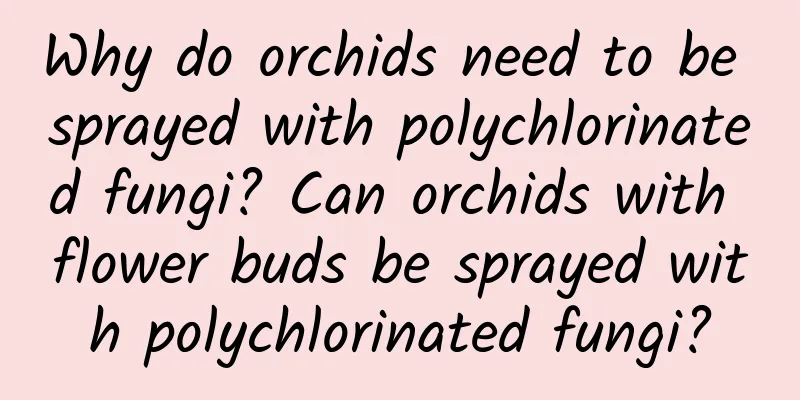Why do orchids need to be sprayed with polychlorinated fungi? Can orchids with flower buds be sprayed with polychlorinated fungi?

|
Many of my friends have orchids planted at home. They may have heard from friends that they need to spray flowers and plants with Multi-Fungus. Many of my friends are curious whether orchids also need to be sprayed with Multi-Fungus. In order to prevent leaf rot and black leaves, of course they need to be sprayed, but do orchids also need to be sprayed with Multi-Fungus when they have flower buds? If they do, can they be sprayed directly on the flower buds? Let us take a look at how to spray orchids correctly! Why do orchids need to be sprayed with polysaccharides?First of all, the purpose of spraying carbendazim is to kill bacteria. Because the indoor ventilation effect is very poor in winter, and the temperature is low, it is easy to breed bacteria and cause rotten leaves and black leaves. This requires us to spray carbendazim regularly to prevent it in advance so that the above situation will not occur. If the indoor ventilation and lighting are not very good when spraying carbendazim, water droplets will adhere to it for a long time after spraying, especially on the flower buds, which can easily cause the flower buds to rot, so it is best to avoid it as much as possible. Can I spray polychlorinated fungus on orchids with flower buds?It is fine to spray directly on the flower buds, but you need to avoid it if the orchid is blooming, otherwise the orchid will have spots. In the same pot of orchids, one bud of the orchid was sprayed with carbendazim, and the other bud was sprayed with plant ash water. When the flowers unfolded, the results confirmed by practice showed that the flowers of the former were dull in color, while the flowers of the latter were bright in color. Because the flower buds sprayed with carbendazim are eroded by the chemical components after being mixed into the flower buds, the color of the flowers becomes dull. However, the flower buds sprayed with plant ash water play a role in supplementing various elements, making the flowers bright in color. Therefore, it is recommended that when spraying carbendazim, it is best to avoid spraying on the flower buds to avoid affecting the bright color. The correct method of spraying polychlorinated fungusCarbendazim is the most commonly used fungicide and is widely used in many crop plantings. Its main function is to kill bacteria and preserve food. It should be noted that if carbendazim is used too much, pests may develop drug resistance, so it cannot be used alone. The correct method is to use Huhuashen first if you find insects, and then use Duojunling after a few days. This effect is also very good, but they cannot be used together. Remember to ventilate more and not too humid, so that there will be fewer insect pests. Therefore, there is no need to avoid flower buds when using carbendazim. And when using Flower Protector and Carbendazim, remember to dilute them with 200 times water before spraying or pouring them along the wall of the pot. Find a mineral water bottle, which is usually 500-600ml. A small bottle of Flower Protector is about 5ml. Put half of the Flower Protector in a mineral water bottle. Or look for a 1000ml beverage bottle, clean it and add a small bottle of Flower Protector to it. |
>>: What to do if the leaves of Christmas cactus wilt? Why do the leaves of Christmas cactus wilt?
Recommend
Causes of premenstrual pelvic effusion
Pelvic effusion is a disease that many women will...
How to deal with ectopic pregnancy
I believe that everyone is familiar with the symp...
Vaginitis during pregnancy
In our daily life, we don’t know much about vagin...
What causes nosebleeds in late pregnancy?
After a pregnant woman becomes pregnant, the estr...
Is the juice diet reliable?
Searching the keyword "juice weight loss met...
Know more about medicine | Why shouldn’t you take nitroglycerin tablets while standing?
Aunt Wang suffered from angina pectoris two month...
What causes stomach pain during early pregnancy?
Generally speaking, abdominal pain in early pregn...
Health secrets for the five special areas of a woman's body
Special Zone 1: Abdomen and Umbilical Cord Health...
Why do I have stomach pain during sex?
Women's bodies are inherently weaker than men...
What foods are good for cervical cysts?
A gynecological disease that often troubles women...
Why can't masks with valves be used? Can masks made of meltblown fabric protect against viruses?
A mask is a sanitary product worn on the mouth an...
QuestMobile: The number of users of smart wearable APP industry will reach 140 million in August 2024, a year-on-year increase of 8.4%
According to the latest data from QuestMobile, in...
Why do I have cramp-like pain in my uterus and can’t move?
The uterus is a very important organ for women. I...
How to solve breast pain and tingling
Breast swelling and pain may be caused by mastiti...
What is the diet like after breast hyperplasia surgery?
As the economic pressure on every family in moder...









